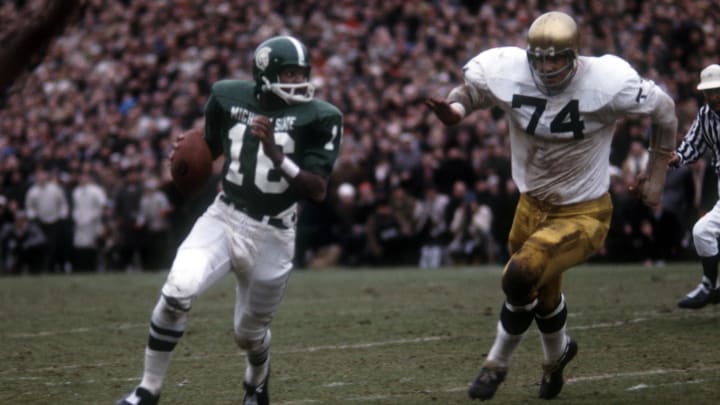The 3 Most Memorable Games in MSU-Notre Dame Football History

With the announcement of Michigan State and Notre Dame's rivalry returning with a home-and-home series slated for 2026 and 2027, memories of a great Midwest college football conflict are resurfacing. The rivalry is storied, spanning the golden eras of both programs, led by the likes of Frank Leahy, Biggie Munn, Duffy Daugherty, and Ara Parseghian, to the doldrums of John L. Smith and Charlie Weis.
The battle was legendary after the Megaphone's arrival in 1949. It helps that there was imbalance in the 1950s, when Michigan State was reaching its peak with two legendary coaches, and Notre Dame hit a rough patch of coaches between Frank Leahy and Ara Parseghian. Both programs reaching their heights at a moment in time when another traditional power like Michigan was at it's low-point helped fuel the competitive spirit.
The last time the two teams played was 2017, when the Fighting Irish jumped to an early 14-0 lead in Spartan Stadium and the Spartans' offense could not click in a 38-18 defeat.
The Megaphone has been in South Bend since.
Notre Dame leads the all-time series 47-29-1, but Spartan Nation wants to remember three games in particular (and an honorable mention) that have proven to be memorable for the Green and White. A testament to the quality of these iconic battles is that all three were tied at the end of regulation.
Honorable Mention
2013: No. 22 Notre Dame beats Michigan State, 17-13
This game will be best remembered as the catalyst that began an 10-0 run, a Big Ten championship against a team with an even bigger undefeated run, and the first Rose Bowl victory in nearly three decades.
The game helped move the needle in favor of eventual starting quarterback Connor Cook, who finished 16 for 32 with 135 passing yards and a touchdown. Cook was still in a contested battle with Andrew Maxwell.
The game was a well-documented wake-up call. The next week the Spartans' season was potentially on the line with a trip to Kinnick Stadium. Cook excelled, the defense proved dominant, and the Spartans began their Rose Bowl run.
This game, however, was the wake-up call. Spartans fans may wonder "What if?" -- what if the Spartans win this game and play Florida State in the final BCS National Championship? There is a good chance the Spartans could have gone undefeated. There is a good chance they win against Notre Dame and get caught later on in a crucial Big Ten matchup. It was crucial loss for the right reasons and history is history.
3. 2005: Unranked Michigan State upsets No. 10 Notre Dame in OT, 44-41
This game has a huge case to be No. 1. The next two are either more important contextually for the Spartans or had other factors going in their favor to be placed above this one. Interestingly, the next season's version of this contest might hold more weight contextually, as it is looked upon as the game that spelled the beginning of the end for John L. Smith's career in East Lansing.
This Spartans team would finish 5-6 despite averaging 33.8 points per game. Padded from playing behind? Likely. But the 2023 Spartans could not score as much. The 2005 Spartans had one of the program's biggest playmakers in dual-threat quarterback Drew Stanton. Stanton threw for 3,077 yards and 22 touchdowns. Behind him was freshman quarterback Brian Hoyer, who would go on to a prominent Spartans career himself.
The Spartans had a trio of running backs, led by a freshman Javon Ringer, Jehuu Caulcrick, and Jason Teague. The Spartans came into South Bend with a 2-0 record, thanks to offensive showcases against Kent State and Hawaii.
2005 was supposed to be the mark of a big turnaround for the Irish, with the semi-controversial hiring of first-year head coach and former New England Patriots offensive coordinator Charlie Weis. Weis had three rings from calling plays with the first iteration of the Brady-Belichick dynasty.
Stanton had eight passing touchdowns entering the contest. He continued his hot start against a good Irish defense, going 16 for 27 with 327 yards and three touchdowns. Despite turning the ball over three times, allowing 594 yards of offense, and controlling the ball for just 15 minutes, the Spartans gave the Irish their first loss of the Weis era when Teague broke free for a 20-yard overtime touchdown. The defense does not get enough credit for holding the Brady Quinn-led Irish to a field goal in overtime.
The Spartans' 2005 season would prove mostly forgettable. The Irish would develop into a formidable team that season and were a "Bush Push" away from knocking off Pete Carroll's juggernaut USC Trojans, who had 27-straight wins at that point.
2. 2010: Michigan State stuns Notre Dame in OT, 34-31 (The "Little Giants" Game)
The game did not bring intrigue at first. Unranked Spartans and Irish. A 2-0 Mark Dantonio squad, yet to make a name for themselves, against a 1-1 Brian Kelly team. With hindsight, it this game has an argument to be the turning point for the Dantonio era.
This Spartans roster was one of Dantonio's finest. Quarterback Kirk Cousins led a devastating one-two punch rushing attack with Le'Veon Bell and the criminally underrated Edwin Baker. Two explosive wide receivers in BJ Cunningham and Keyshawn Martin. Martin was the home-run playmaker.
Defensively, All-American linebacker Greg Jones (dominant despite or because it was not his natural position) and underrated Eric Gordon anchoring the second level. Marcus Hyde, Trenton Robinson, and Johnny Adams roaming the secondary. Defensive tackle Jerel Worthy causing havoc up front.
The game started off as a defensive slugfest. Just one touchdown apiece in the first half. Notre Dame scored first. The teams traded turnovers. Spartans held strong defensively and turned their second interception of Dayne Crist into six points. More punts. Tied at the half.
Things uncorked in the second half. Baker broke one for over 50 yards and the lead. The Irish responded with a methodical six-play scoring drive to tie it. The Spartans regained the lead with a seven-minute drive capped by a 16-yard rush from Bell, whose patented patience followed his blockers to the endzone.
The Irish scored another touchdown. And another. Then a Cousins-led four-play drive to tie the game with just under eight minutes left. The game was a stalemate in the waning minutes, but overtime would lift the game from unranked September matchup to a program's turning point.
Simple: Tie the game 31-31 in overtime. 4th and 14. Nobody in their right mind would try anything other than kicking the 46-yard field goal. Placeholder Aaron Bates takes the snap and makes the throw of his life to a wide open Charlie Gantt. Ballgame.
The game was the catalyst for everything to come for Dantonio's program. Dantonio would suffer a heart attack and not return to the sideline until the Michigan game, a commanding 34-17 victory in the Big House. The Spartans would climb as high as No. 5 in the polls. 11-2 record and a share of the Big Ten championship. Everything would be in place for a memorable 2011 season and a whole lot of winning from 2013 to 2015.
1. 1966: No. 1 Notre Dame and No. 2 Michigan State tie 10-10 in "The Game of the Century"
Arguably the best team in Michigan State history. George Webster, arguably the greatest player to don the Green and White, playing a hybrid safety-linebacker. Daugherty called it the "roverback." Before the modern game made it cool. Eventual first overall pick and Super Bowl-winner Bubba Smith at defensive end. Another All-American at linebacker in Charles Thornhill.
That was just on defense.
Offensively, two All-Americans in the backfield with running back Clinton Jones and fullback Bob Apisa. All-American wide receiver Gene Washington proved a vertical threat. Quarterback Jimmy Raye was a dual-threat before they knew to call it that. Raye threw for 1,110 yards and 10 touchdowns while rushing for 486 yards and five rushing touchdowns.
The team outscored opponents 293 to 99.
All this talent was led by the iconic Daugherty. Amidst the backdrop of Daugherty's crusade to integrate college football. The Spartans ran through their nine opponents on a collision course with the No. 1-ranked Irish in the season finale. No BCS to determine the national champion. No ESPN College Gameday. Two iconic coaches that defined the era, two loaded teams.
Remember, the Irish had future Pittsburgh Steelers quarterback Terry Hanratty. They had future Steelers legend Rocky Bleier at running back. NFL Hall-of-Fame defensive end Alan Page was just another All-American for the Irish at that point.
The Irish were without a star in running back Nick Eddy, who fell (literally) to injury stepping off the train in East Lansing.
In front of a Spartan crowd wearing "Kill, Bubba, Kill" buttons, Smith knocked Hanratty out of the game early into the contest. The Spartans took a 7-0 lead in the second quarter. They extended it to 10-0 with a field goal. The Irish scored before the half to make it 10-7.
In the second half, the teams traded turnovers and beat-downs. The Irish tied the game 10-10 in the fourth quarter.
And then, Parseghian infamously chose to run out the clock as opposed to driving for a game-winning field goal.
Many were incensed. Many were confused.
The great Sports Illustrated writer Dan Jenkins eloquently forecasted the game's legacy in his cover story for the issue printed a week later.
"Old Notre Dame will tie over all," Jenkins wrote. "Sing it out, guys. That is not exactly what the march says, of course, but that is how the big game ends every time you replay it. And that is how millions of cranky college football fans will remember it ... For the people who saw it under the cold, dreary clouds or on national television, suddenly all it had was this enormous emptiness for which the Irish will be forever blamed."
There would be games dubbed the "Game of the Century" in the years to follow. In fact, the next big one was just three years after, between Darryl Royal's Texas Longhorns and Frank Broyles' Arkansas Razorbacks. That contest's 1-point differential on the scoreboard would ensure no controversy.
Part of what makes Game of the Century '66 so memorable is the mystique of the final score. The game was rated the 20th greatest college football game by ESPN on their list of the 150 greatest games in 2019.
The game is the reason that an elder generation of Spartan faithful, this reporter's grandfather included, considered beating Notre Dame nearly as important as a triumph over Michigan. Nearly.
Fittingly enough, the matchup between the teams in 2026 will be the 60th anniversary of the greatest contest they ever played.
Don’t forget to follow the official Spartan Nation Page on Facebook Spartan Nation WHEN YOU CLICK RIGHT HERE, and be a part of our vibrant community group Go Green Go White as well WHEN YOU CLICK RIGHT HERE.
